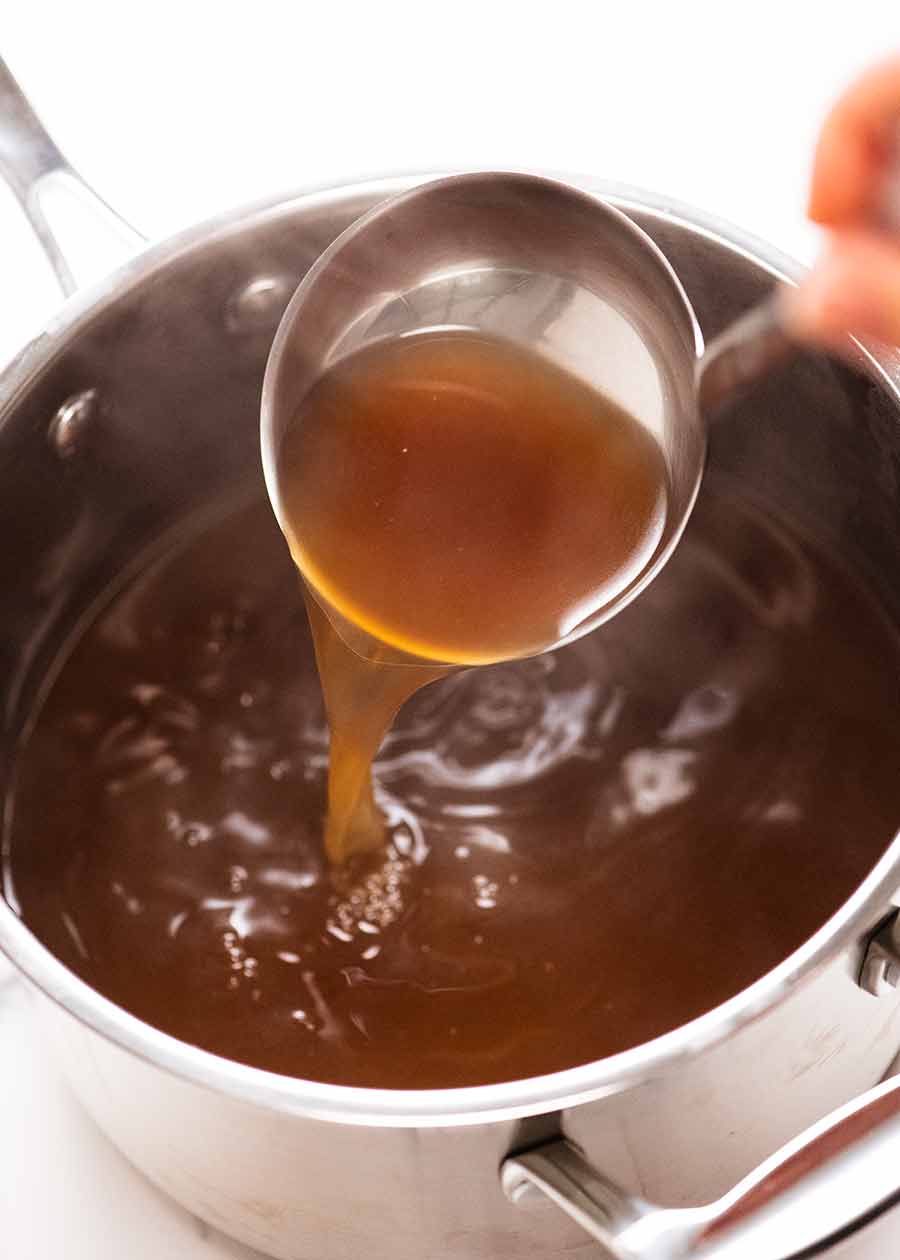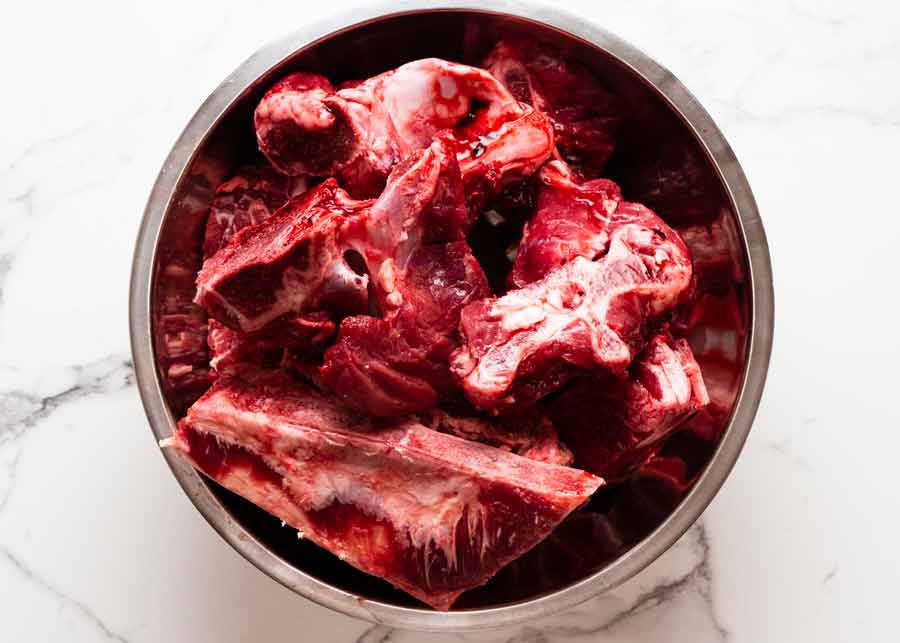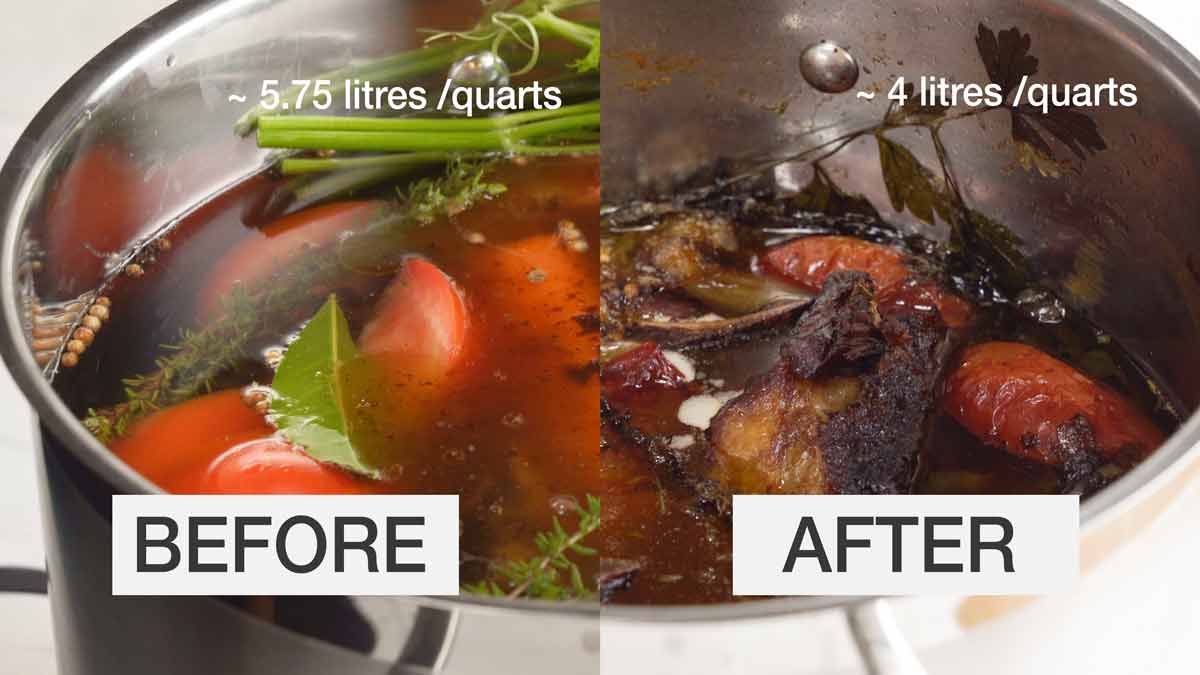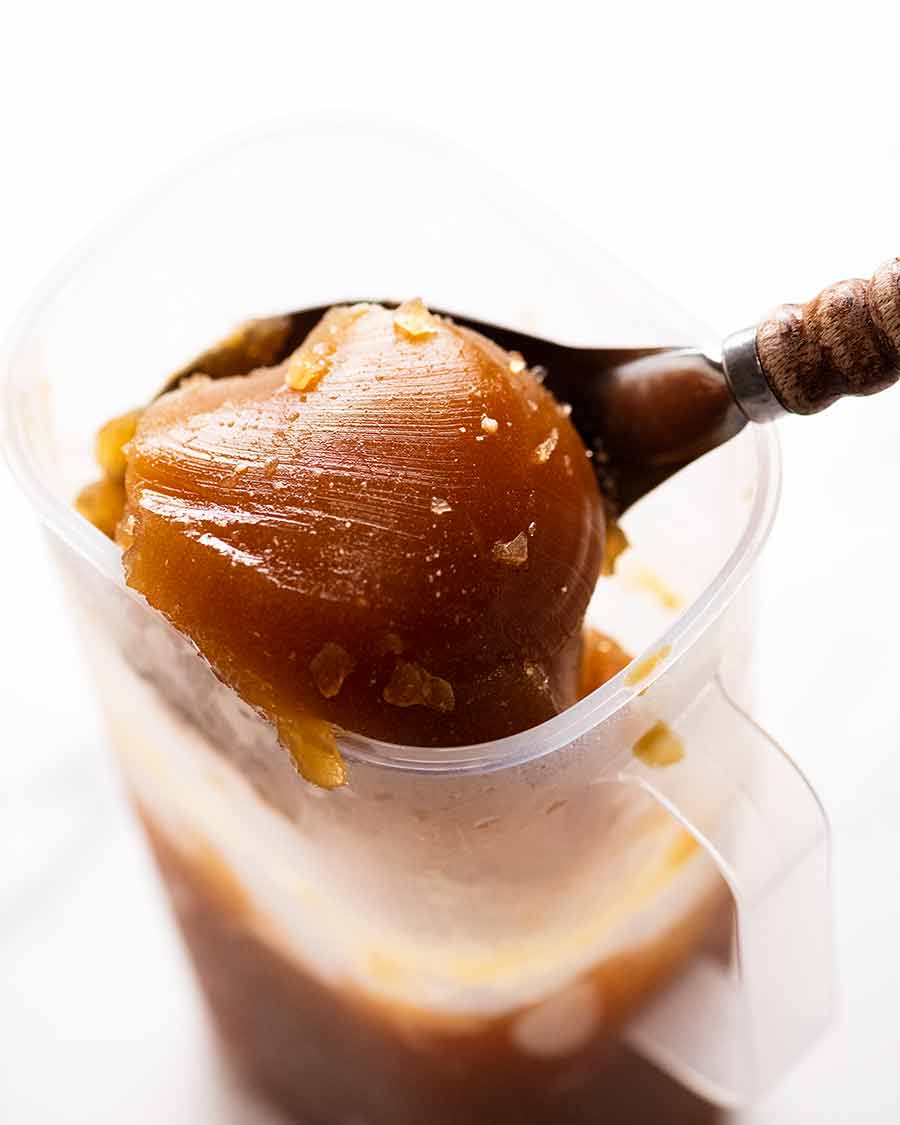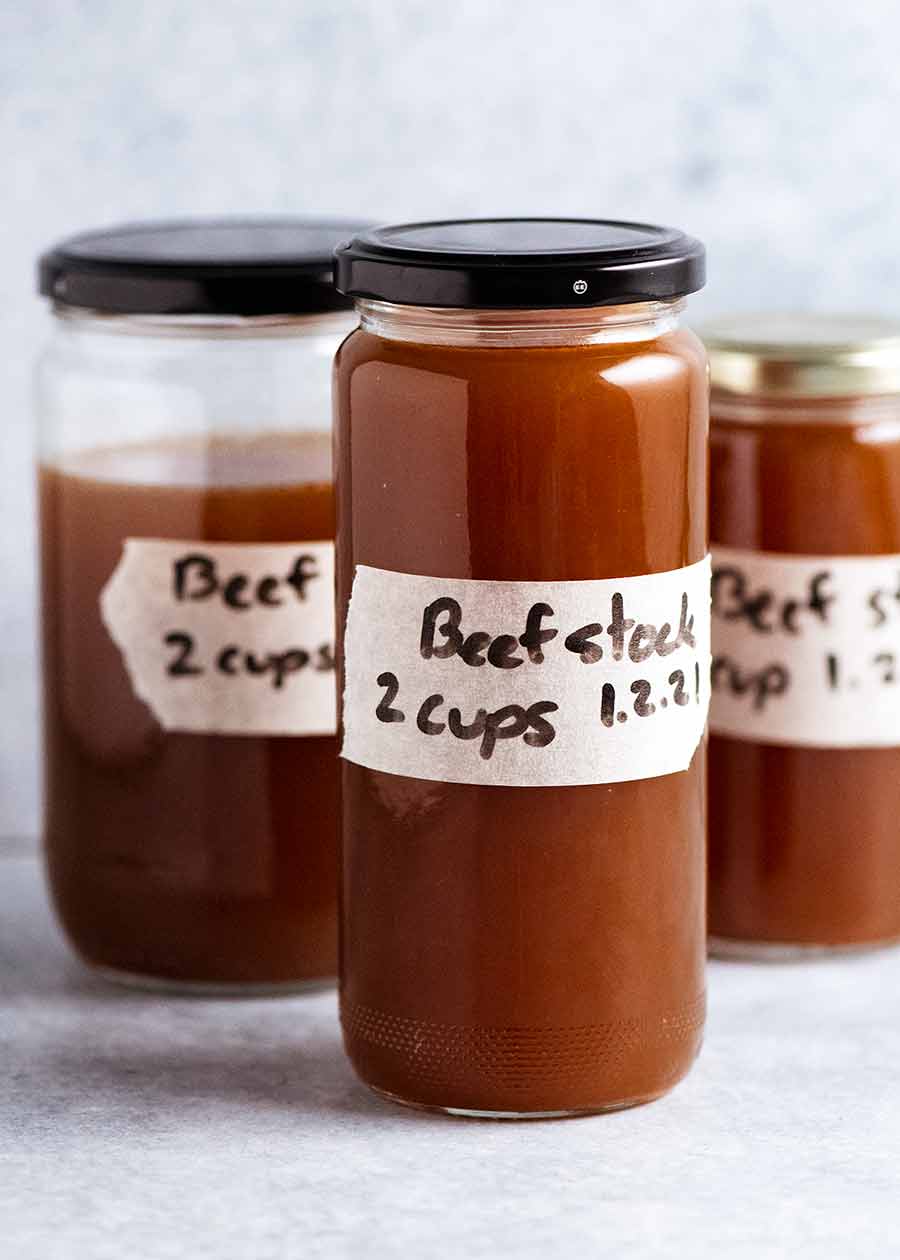It takes time to make, but if you truly want the best, it’s worth it! More stocks: chicken stock | vegetable stock Let me say from the outset: homemade beef stock requires effort. It takes time – I’m talking minimum 4 hours, up to 10 hours is best – there’s a pile of hot bones to discard, and big cooking vessels that’ll need cleaning. So one might ask:
Why make beef stock at home?
Because it is so vastly superior to any store-bought stock. While I think that (most) store bought chicken stock is actually pretty good these days and vegetable stock is passable, beef stock has never been that great. Homemade beef stock has:
Far better flavour – Store bought stock does not compare to real, freshly made stock. A simple taste is all it takes to confirm this;Richer mouthfeel – Gelatin from the bones and connective tissue in beef bones is what gives a stock its full-bodied richness and mouthfeel when used in soups and stews etc, as well as natural thickness when highly reduced for use as a jus or in sauces. Store-bought stock lacks this quality;More versatile because it’s unsalted – Store-bought stock is almost always salted. This is fine when used at normal concentrations, but if stock is reduced a lot when making ragus, sauces and so on, the salt can become excessive – yet there is little you can do about it. Homemade stock on the other hand is unsalted, so you will never have this problem and can control seasoning in the finished dish; andCheaper than high quality store-bought stocks. Yes, regular supermarket packet beef stock (eg. Campbell’s) is cheaper than homemade stock. But it also tastes quite artificial, because producers are yet to successfully mass-produce cheap beef stock to a decent level of quality. High-end packaged stocks are better, but are very expensive by comparison.
Homemade stock is one of the big things that differentiate home and restaurant cooking. Good restaurants always make their own stocks, and is the secret to why their dishes often have that richer, deeper, “restaurant-quality” taste to them.
What goes in homemade beef stock
The key ingredient to make a really good beef stock is meaty bones. No meat, no flavour! You need 2 1/2 kg / 5 lb of beef bones to make 1 1/4 – 1.5 litres / quarts of stock (5 – 6 cups). In addition to bones, we also want aromatics which add character, deepen the flavour, add a touch of sweetness and also provide some colour. Here’s what I use:
Bay leaves, thyme, parsley, black peppercorns – Herb and spice aromatics, fairly standard;Onion, celery and carrot – Again, familiar building-block ingredients in the stock which add subtle sweetness and flavour;Tomato – Something you don’t see in the most basic beef stock recipes, this adds a touch of sweetness and colour, deepening it to a desirable rich dark brown;Cider vinegar – A great cheffy touch, a little vinegar helps extract nutrients out of the bone into the broth;Coriander seeds – Another little cheffy tip, it adds another layer of subtle complexity to the finished stock. You can’t separately identify the flavour, but a little taste is all it takes to know you’ve made something special!
Though it takes hours and the manhandling of a (very!) large stock pot, it’s actually very straightforward to make this beef stock. Also, the nice thing about this beef stock recipe is that there are 3 ways to do the slow simmer part:
How to make beef stock
This is what the stock water level looks like after 8 hours on the stove. The water level should reduce from around the 5.75 litres / quarts mark to around 4 litres (noting this is counting the bones etc still in the water): If you do the faster, 3 hour simmer … If you choose this option, which we often deploy because there aren’t many times when I can have a pot of stock simmering away all day, we simmer on a marginally stronger heat level to reduce the water faster. In addition, we reduce the stock to concentrate the flavour after straining it. The flavour difference between 3 and 8 hours? Well, of course an 8 hour simmer yields a better result. But practicality comes into play here, and while the extra 5 hours does produce an even better result, a 3 hour simmer will still give you an exceptional stock;
Straining, storage and using
Once the stock has reduced, it’s a matter of straining, discarding excess fat then storing for use! I like to store stock in 1- or 2-cup portions, labelled, in the freezer. It’s important to cool rapidly to prevent bacteria from growing (they love cosy warm environments!) so we can get it in the fridge ASAP. Never put a large hot pot of stock in the fridge otherwise you will significantly raise the internal temperature of the fridge – that’s bad! This is what beef stock looks like when chilled and the fat has been removed. It solidifies into a jelly because of the gelatin. Gelatin is what gives the stock that fine-dining restaurant, rich mouthfeel. Store bought stock is always liquid because it has little gelatin.
How to use homemade beef stock
To use homemade beef stock, you can either reheat in the microwave or on the stove to return it to a liquid so it can be measured out. It melts very quickly – literally in a minute or two. It can be added straight into dishes in cold jelly form too. For me, it’s just a question of whether I need to measure it or not – it’s harder to accurately measure out jelly!
What to use homemade beef stock for
Use homemade beef stock for any recipe that calls for beef stock or beef broth. Your finished dish will be multiple times better than any version made using store bought, with a far richer, deeper flavour and none of that undesirable artificial edge that store bought beef stock has. You will gain exceptionally good results when used especially in slow-cooked dishes such as stews, as well as soups, sauces and gravies (plain or mushroom!). Here are some suggestions:
IMPORTANT: Salt adjustment when using!
The only thing to note with homemade stock is that you will need to add more salt to whatever dish you’re making. This is because most recipes – including mine – presume store-bought beef stock. Store-bought stock is salted, whereas home-made is unsalted. Therefore, you need to compensate for this difference. As a rule of thumb, you will need to add 1/3 teaspoon of cooking or kosher salt for every 1 cup of homemade beef stock in order to have the same level of salt as low sodium store bought stock. And with that, I’m done! The first of a series of homemade stocks that I plan to share. Next up, fish stock! – Nagi x
Watch how to make it
Life of Dozer
Dozer agrees that meaty bones are best.
